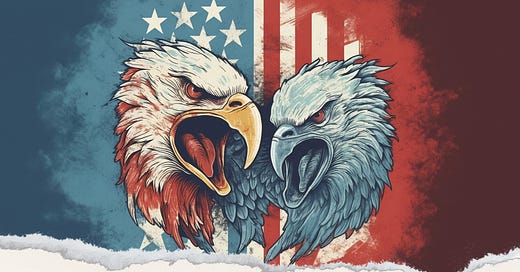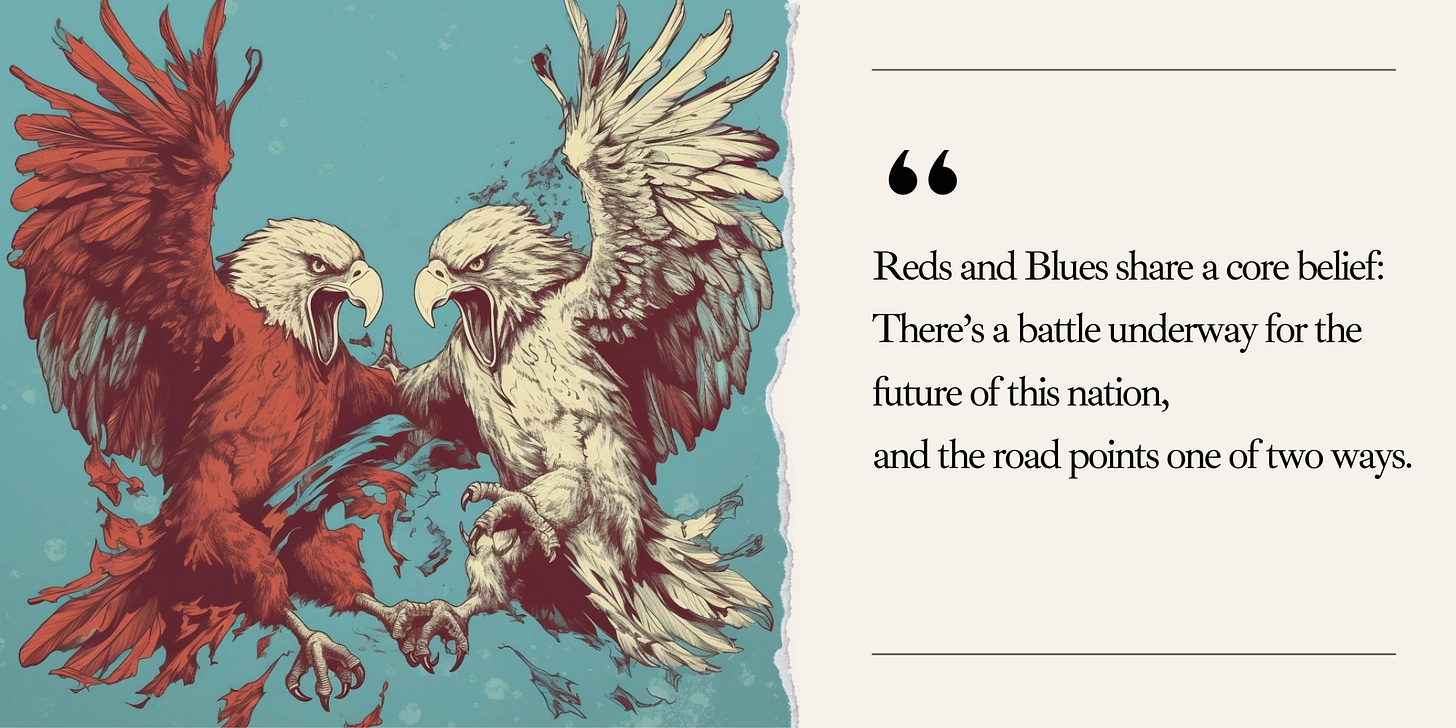The Inner Trench: A Brief Anatomy of the Culture War
Since World War 2, the wars waged in the West have trended toward the symbolic: the proxy scuffles of the cold war, the “wars” on drugs and terror, the occasional trade war, the looming cyberwars – it’s been harder to define exactly who the enemy is, what the methods of war are, and what winning and losing really mean.
Continuing the trend, another war has emerged since the 1990s. An even fuzzier one. One with little physical violence, but which nonetheless threatens to tear apart our social fabric.
Enter the Culture War. Coined by sociologist James Davison Hunter in 1991, the term refers to thousands of small battles being waged daily - from government halls to classrooms, corporate boards to the mediasphere, extending all the way through to our everyday social interactions.
Its battlefield is any politicized issue involving a deeper clash of values. A few examples:
Is gender a function of biological sex? What is hate speech, and should it be allowed? Should abortions be legal and/or funded? Should illegal immigrants have asylum rights or a path to citizenship? How far should trans rights go? Should guns be banned or severely regulated? What constitutes rape? What level of threat does climate change pose? Do past injustices justify special privileges today?
The emotions generated by these clashes keep the Culture War at the forefront of our public square.
But why do we call it a “war”? What is it really about? Who are its casualties? And will it ever end?
The Culture War Takeover
Political disagreement isn’t new. What’s new is this level of polarization and animosity.
More in Common– a non-profit group of researchers who empirically study the political makeup of modern democracies - estimates that partisan animosity has grown from about 50% in the 1980s to well over 80% in recent years.
Within government, things are even worse. Political scientists at UCLA estimate that polarization in Congress has roughly doubled since the 1970s. Pew reports that the gap in political values between Republicans and Democrats has also doubled – but this time since as recently as the mid-90s. Polarization even shapes housing decisions: a study analyzing 180 million registered US voters found that politically like-minded people now cluster in the same neighbourhoods much more than they used to.
This war is waged by two teams - let’s call them Reds and Blues (I almost went with Bloods and Crips … but this fire hardly needs more fuel), brought together by a shared belief:
“There’s a great battle underway for the future of this nation, and the road points one of two ways.”
Around this belief, culture warriors have tacitly agreed to a Culture War Agreement composed of three main elements:
1. Airtight Dualism: Important issues are to be divided into two (and only two) positions, with a clear demarcation line between them. They’re then to be bundled in two batches: one Red, one Blue. People can then mostly be classified as friend or foe, based on the colour of the bundle they choose.
2. Selective Focus: If an issue can’t be split in two, or if it unites people across team lines, it should be ignored. Attention should be re-directed to the contrasting bundles whenever possible.
3. A Bias for Conflict: Conflict with the other team is inherently good. Because so much is at stake, winning is its own justification; the ends mostly justify the means.
Every time an issue springs into public view – a pandemic, a war, a minor campus issue, it hardly matters, and so on - the teams scramble to organize it along Culture War fault lines. While the details abound, the core difference between them ultimately comes down to the different narratives they use to build their respective worldviews.
Reds want to re-make society in the image of a romanticized past. They’re drawn to the story of nostalgia: “We were once great,” nostalgia says, “but we’ve lost our way.” Trump played it to fiddle with his MAGA campaign. Appeals to the loss of the traditional values and standards of the past are what mostly galvanize Reds.
Blues, on the other hand, want to mould life in the shape of an idealized future. Their story is that of utopia: “Our past was filled with ignorance,” utopia says, “but we finally know what’s really important.” They appeal to “change” and “progress”, and usually frame their moral arguments as quests for safety or equality.
Both teams also share a sense of dread about the present. As a result, they’re vulnerable to frequent bouts of moral panic and anxiety. Stuck in this loop, they find it hard to spend much time focusing on the remarkable progress we’ve achieved, or the opportunities that lie ahead. For this reason, the Culture War feeds a growing Gratitude Gap.
Views From the Wasteland
So, who cares? Well, we should. For at least three reasons.
First, there’s credible evidence showing that chronic exposure to negative information is terrible for mental health. Social media platforms – ever insatiable for engagement – have become factories of anger and negativity. Posts about political out-groups are shared or retweeted about twice as much as posts about the in-group. Researchers at Yale found that design features in the platforms were responsible for the elevated levels of outrage people experience online. The effect on young people – especially young girls - is even more pronounced. The tension is clear: what’s good for big tech is often bad for human beings.
So why do we keep returning to this well of darkness? Because the emotional patterns we experience online can become addictive – sometimes in deceptive ways.
Through fMRI imaging, psychologist Drew Westen found that participants who were shown threatening political information immediately saw activation in brain networks associated with negative emotion and “responses to punishment”. The twist is what happened next: when they moved their attention away from this information, they got a hit of dopamine. “If this is true,” writes Jonathan Haidt (After Babel), in The Righteous Mind, “then it would explain why extreme partisans are so stubborn, closed-minded, and committed to beliefs that often seem bizarre or paranoid.”
Second, demonizing those we disagree with weakens the kind of pragmatic problem-solving that ultimately helps everyone.
Energy spent fighting enemies is energy diverted away from designing and implementing win-win solutions. In a study called Fear and Loathing across Party Lines, researchers at Princeton and Stanford found that hostile feelings for the opposing party promote confrontation rather than cooperation even when the latter is more productive.
Examples litter our political wasteland. Three-quarters of Americans believe there should be a naturalization path for the children of illegal immigrants, yet the GOP fights bill after bill that would provide this. A full 85% believe race shouldn’t be a factor in college admissions, yet liberal colleges like Harvard still use it prominently to determine who gets in, leading to lengthy and expensive lawsuits like the one Students for Fair Admissions is waging against it. Debt ceiling negotiations used to be simple and nonpartisan – both parties benefit from a functioning government that meets its obligations - but it’s now an uber-politicized recurrent issue with a cascade of negative consequences that ultimately doesn’t advance either side’s interests.
The “tragedy of the commons” aspect of this is obvious. Each side may be driven by the desire to beat the other in the short term. But in the long run, everyone loses from the lack of pragmatic collaboration. On one level, the Culture War can be understood as a modern form of political cannibalism.
Finally, the Culture War paints a distorted picture of society.
More in Common’s fantastic Hidden Tribes study shows that culture warriors are part of “Wings” – minority splinter groups with intense opinions who consider the opposing splinter group its enemy. But 67% of people are actually part of an “Exhausted Majority” – a group comfortable with the kind of pragmatic and nuanced compromises the Culture War obscures. In addition to being more devout about their cause and therefore more combative, the study also revealed that the “Wings” on both the right and left were also more culturally homogeneous (in this case, Caucasian) than the exhausted middle, which was more ethnically diverse.
In dominating agendas through sheer loud relentlessness, culture warriors have induced a kind of mass delusion on the kind of diversity – political and ethnic - that actually exists in modern society.
So, if it’s bad for our health, unpragmatic, and delusion-inducing, why are we so hellbent on waging this entirely optional inner war?
When Parts Devour the Whole
Modern life is spiralling into change at a dizzying speed. An ambient state of uncertainty is now its backdrop. Social issues are, therefore, more complex than ever.
In response, converting them into simplified, bite-sized clips of binary truth has become a guilty pleasure for the politically inclined. It restores a sense of certainty and a familiar kind of tribal belonging. It also creates content that plays well on social media, turning democracy into a blood sport for our viewing pleasure.
The damage can be actively destructive. As the culture war drum beats on, careers have been wiped out. People have gotten cancelled. Children have been instrumentalized. The darker side of the culture war reveals its true center, one it shares with all other wars: the good old quest for power and influence.
The terrain of the culture war is one where jobs, grants, budgets, social media attention, speaking engagements, sponsorships, subscriptions, book sales, political offices, and bureaucratic agendas all play out. The whole thing reeks of careerism.
The tragic dualism of this war – all eyes on one battlefield, issues cherrypicked, only two teams allowed - may, to a large degree, simply be a reflection of the two-party system in the US. This two-tone political reality gets magnified by the astronomical growth of government since the 1990s:
There’s simply more power and money up for grabs in anything that touches the political realm, and people want their piece of the action. Attention, control, and career benefits are tinder to this fire. That it comes at the expense of health, pragmatism, or even truth itself hardly weighs in.
As the West’s military rivals receded, we grew into the most abundant society ever. But our aggressive drives didn’t disappear; they simply turned inward. Our power games are now less about an external enemy, and more about the one on the inside. The culture war is our inner trenches.
And so, it rages on.
No peace treaty or individual decision can end it. It keeps spreading metastatically through the organs of society.
The culture war will only end when we realize that what we've all lost – social capital, collaborative problem-solving, and emotional well-being - outweighs what some of us have gained in power and influence.
In the meantime, historian Arnold Toynbee’s warning echoes loudly:
Civilizations don’t die of murder. They die of suicide.






